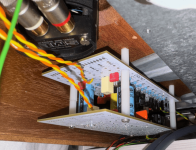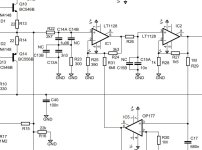So that I understand this correctly:I'm hearing artifacts in Terence Trent D'Arby's voice, or the snare drums, I've never noticed before.
Do you think the artifacts are caused by your grounding or by OREAD or are they part of the recording?
I try to say the recording comes out better than I've ever heard it. Definitely to the credit of OREAD and all good advice I've picked up from our conversations. Every record sounds like a new experience. So much more detail and separation. Right now I'm listening to a recording from -68 where Steve Stills is improvising with fellow musicians, Al Kooper, keyboards, Harvey Brooks on bass to name two.artifacts are caused
There are still tweaks to perfect things, but at the level I'm listening I'm amazed.
OK, got it. THXI try to say the recording comes out better than I've ever heard it
The other PCBs I shipped are in the works in the USA, Sweden, Norway, the Netherlands and Italy. We will have to wait and see whether we get to see or read anything from them.
btw: two sets of version 6 are currently still available
Perhaps we will see builds with other boards in the future.
Someone had presented an SMD board earlier in the thread. Is there anything new about this?
btw: two sets of version 6 are currently still available
Perhaps we will see builds with other boards in the future.
Someone had presented an SMD board earlier in the thread. Is there anything new about this?
Just a sneak peak under the tonearm board of an old Thorens. Everything isn't in place yet. Especially I haven't solved how all conductors should enter or exit the turntable. But the sound is already marvelous. Without any kind of shielding even if the motor and its control board, with mains transformer, also resides in the plinth.
Attachments
The expert for the installation of an MM-EQ in the chassis of the TT should be Nick S., he propagates this procedure.
I have only done this once before, with an original Supra1982, over 30 years ago. It worked great, but the belt drive used a real DC high-speed motor.
Maybe Nick S. can help better than I can - in this case.
This case actually calls for a tiny SMD-equipped circuit board
Yes, the best place for preamp is a TT inside, see my full phono preamp with smd components [ https://www.patreon.com/posts/insaidnyi-ot-vip-72574505 ]
H ya I'm going to work on a rudimentary PCB, but there's no way I'll get to a test setup before the weekend
I would breadboard it first to be sure it is working as it should before going to the expense of creating a PCB.
@egellings
Didn't you read the whole thread? Obviously not.
There is already a PCB, (second edition), and some OREAD units in operation.
Didn't you read the whole thread? Obviously not.
There is already a PCB, (second edition), and some OREAD units in operation.
I did not read the whole thread; I just happened upon this page of it, and as a result was not aware of the availability of a PCB for it.
MC-PRE
A completely different option is a simple, negative feedback AF preamplifier. The concept of the EXakt Mk2 uses this approach to connect an MC system directly to the AllInOne EQ.
But OREAD is basically designed for MM systems.
HBt.
Dear friends of the OREAD-RIAA equalizer,
it would be very nice if you could report on your experiences and share them with the rest of us. Sound descriptions, impressions, pictures, maybe smd-versions ..!
Happy new year,
kindly
HBt.

it would be very nice if you could report on your experiences and share them with the rest of us. Sound descriptions, impressions, pictures, maybe smd-versions ..!
Happy new year,
kindly
HBt.

I jump straight to this narrative style.The best solution also sonically
So technically and sonically the best, i.e. the only true solution to the simplest equalization problem in the world ...is to use passive corrections in 2 steps.
I agree with the choice of material, but it doesn't have to be much better than 1%. If we approach this tolerance range, then we are on the right track, provided that our time constants also match the target-correction to be realized.It is also important to use high quality PP capacitors selected below 1%
@HRDSTL
But you could explain the first one /point in a technically correct way when you get the chance - and I hope we can agree that "many roads lead to Rome".
kindly,
HBt.
Psst
This discussion thread should be all about the incarnations of the OREAD-EQ. I hope that the original thread creator will speak up again after his gosthing - that would be very nice.
I wanted to revive the sound of vinyl, I have some good pieces from 2000 to 2005, which are not available on stream and if they are, they are in poor quality. At the moment I only listen to tidal + dac. Many of the MM preamps published here also have RIAA correction in the feedback, which is not sonically optimal. I'm working on one preamp for MM, topology is from 90's but even then it was able to outperform several times more expensive preamps even from world manufacturers. There were also listening tests and this one outperformed literally all the participants. It was originally designed as follows: discrete input amplifier input pair 2sk170, + two stages of passive correction. In the original wiring were used NE5534, which nowadays is no longer any glory and so I needed to replace them with something better, the requirement was that the IO in THT design and with a maximum power supply up to 20V DC since behind the capacitive multiplier is about 19V. In the end I used the following types in the wiring (LT1028, LT1128, and in the DC servos LT1055, LT1012)
Attachments
- Home
- Source & Line
- Analogue Source
- Oread - a DIY MM phono approach




